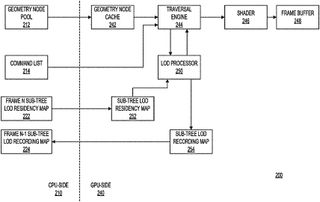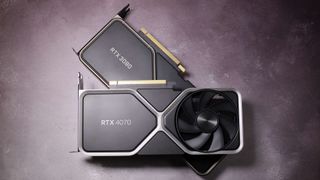Microsoft's new patent promises more efficient ray tracing for the Xbox and that could be a real boon for AMD's graphics cards too
Not all patents ever see real-life applications but this one could be very popular with devs.

Will RDNA 4 fix Radeon's biggest weakness?
(Image credit: CD Projekt)Microsoft's research division has been hard at work trying to make ray tracing a more accessible feature for games of the future. A new patent from one of the team's senior architects describes how the memory and cache load for bounding volume hierarchies (BVH)— structures used to speed up ray tracing—can be reduced by using a similar approach to texture Level of Detail (LOD) application.
While Microsoft's Xbox consoles would be the main beneficiary of this technique, AMD's traditionally ray tracing weak GPUs, and graphics cards that aren't blessed with a ton of VRAM are also a potential winners.
As with all such patents, the details within it are complex but also broad in terms of where they could be used. Its author, Mark Grossman, is a senior architect in Microsoft's research division, specialising in chip development, and he has a long and distinguished career in GPUs (starting with Silicon Graphics, before moving to ATI Technologies, then AMD, and finally Microsoft).
Last year, he had a patent approved for reducing the memory footprint of meshlets, small groups of polygons as used in mesh shaders. His latest patent (via Tom's Hardware) follows a near-identical format. To speed up the process of ray tracing, games use BVH structures, which are a little like a flowchart of the volumes that objects in a 3D world take up. BVHs are split into a large overall map, called a top-level acceleration structure (TLAS), and multiple smaller bottom-level ones (BLAS).
In Cyberpunk 2077, the average size of the TLAS is around 15 to 20MB, but the total BLAS is many times larger than this, running into hundreds or thousands of megabytes. If your graphics card has 16GB or more of VRAM, it's not really a problem but if you have 8GB or less, then it's not hard to see why it can become an issue. And this is especially true of consoles with shared memory pools.
Microsoft's technique avoids using the entire BVH in one go. Instead, small chunks of it are used at a time, and the details of this usage and the part of the BVH in question (called a node) are stored in two lists in the GPU's memory. With each successive frame, the ray tracing algorithm updates these lists, ensuring that only the nodes required to be used in the scene (the rest just not being visible or worth using) are stored in the VRAM.

Note that this system not only reduces the load on the graphics card's memory and the GPU's cache, but it also lowers the amount of ray tracing checks that need to be carried out. Rather than having to constantly traverse across the entire BVH structure to see what rays are interacting with which objects, only those in the lists (called a residency and recording map) need to be checked.
The biggest gaming news, reviews and hardware deals
Keep up to date with the most important stories and the best deals, as picked by the PC Gamer team.
This is important for AMD's graphics processors because unlike Nvidia's GPUs, they don't have any dedicated hardware for accelerating the traversal process. Instead, it's all handled via compute shaders. Both vendors do have specialised units for testing ray-box and ray-triangle intersections, so they both check these things off very quickly, but RDNA 2 and newer GPUs spend quite a bit of time working through the BVH.

Best CPU for gaming: The top chips from Intel and AMD.
Best gaming motherboard: The right boards.
Best graphics card: Your perfect pixel-pusher awaits.
Best SSD for gaming: Get into the game ahead of the rest.
So while all of this work is to the benefit of the Xbox, it would also be a boon to any gaming PC sporting a Radeon graphics card, powered by a RDNA 2 or RDNA 3 GPU.
Yeah, this is all very complicated, and I'm almost certainly over-simplifying it, but the one thing that the best gaming PCs and consoles have in abundance is compute power. So it makes sense to leverage something that, while involving lots of extra but basic calculations, reduces memory and ray tracing loads.
Although Microsoft's patent is primarily targeted towards improving ray tracing performance on its Xbox Series X consoles, the technique could be implemented on any platform, as it's not specific toward any particular hardware. So if you have a mainstream graphics card, like a GeForce RTX 4060 or Radeon RX 7600, then you could well have the chance to enjoy ray tracing in a game in the not-too-distant future.

Nick, gaming, and computers all first met in 1981, with the love affair starting on a Sinclair ZX81 in kit form and a book on ZX Basic. He ended up becoming a physics and IT teacher, but by the late 1990s decided it was time to cut his teeth writing for a long defunct UK tech site. He went on to do the same at Madonion, helping to write the help files for 3DMark and PCMark. After a short stint working at Beyond3D.com, Nick joined Futuremark (MadOnion rebranded) full-time, as editor-in-chief for its gaming and hardware section, YouGamers. After the site shutdown, he became an engineering and computing lecturer for many years, but missed the writing bug. Cue four years at TechSpot.com and over 100 long articles on anything and everything. He freely admits to being far too obsessed with GPUs and open world grindy RPGs, but who isn't these days?
Most Popular






